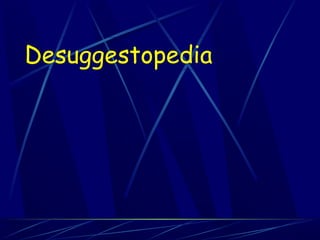
desuggestopedia
- 2. The originator of Desuggestopedia Georgi Lozanov. A Bulgarian psychiatrist and educator. ” Learning is a matter of attitude, not aptitude.”
- 3. The meaning of desuggestopedia suggest => desuggest This method puts importance on “desuggesting limitations on learning.”
- 4. We set up psychological barriers to learning and thus we do not use the full mental powers we have; in order to use our reserved capacity, the limitations we think we have need to be “desuggested.”
- 5. The goal of the teachers The goal of the teachers using the teaching method is to help students eliminate and overcome the barriers to learning and increase their communicative ability.
- 6. The teacher speaks confidently; The teacher should integrate indirect positive suggestions (there is no limit to what you can do) into the learning situation.
- 7. Peripheral learning We perceive much more in our environment than that to which we consciously attend. “When there is a unity between conscious and subconscious, learning is enhanced.”
- 8. Fine arts One of the ways the students’ mental reserves are stimulated is through integration of the fine arts- music, drama, or paintings.
- 9. Enjoy your learning The teacher gives the students the impression that learning is easy and enjoyable.
- 10. Choosing a new identity This enhances students’ feeling of security and allows them to be more open.
- 11. Active concert Teacher will introduce a story as related in the dialog and call the students’ attention to some particular grammatical points that arise in it, she reads the dialog in the target language. Music is played. The teacher begins a slow, dramatic reading, synchronized in intonation with the music. The music is classical and the teacher’s voice rises and falls with the music.
- 12. Passive concert In the phase, the students are asked to put their scripts aside. They simply listen as the teacher reads the dialog at a normal rate of speed. The teacher is seated and reads with musical accompaniment.
- 13. Primary activation The students playfully reread the target language dialog out loud, as individuals or in groups. Students are asked to read the dialog in particular manner: sadly, angrily, and cheerfully.
- 14. Creative adaptation The students engage in various activities designed to help them learn the new material and use it spontaneously. Activities particularly recommended for this phase include singing, dancing, dramatizations, and games.
- 15. ~Thank You ~
